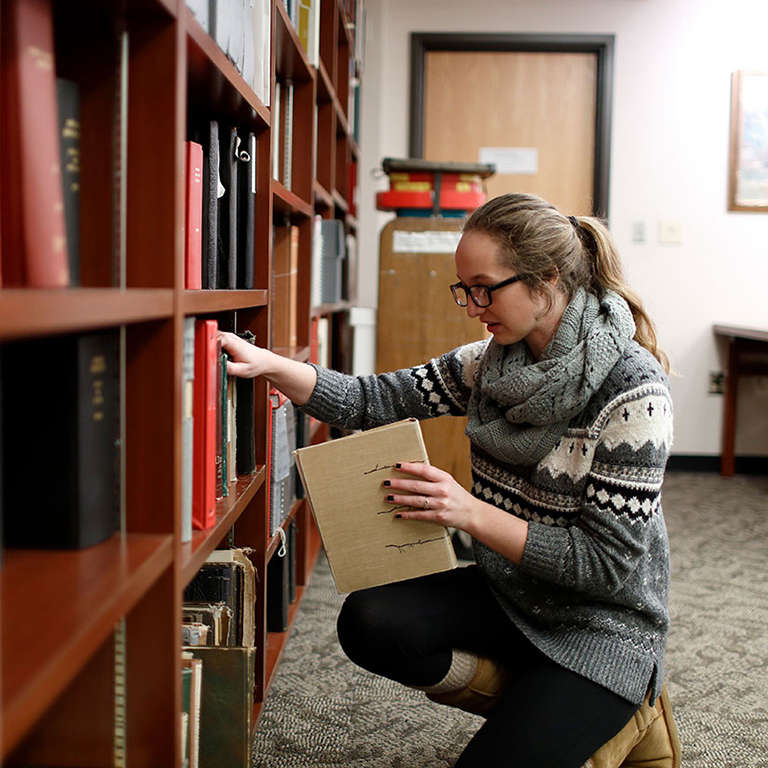Inside IU Bloomington
By Sheila Raghavendran
One hundred ninety-six.
That’s how many years since IU was founded in 1820, and that first version of the university is quite different from today’s campus. In anticipation of the 200-year anniversary of the university’s founding, interns for the Office of the Bicentennial have been researching IU’s history for projects that will be featured on the IU Bicentennial website. Their projects will be featured at an open house from 2 to 4 p.m. Friday, Dec. 9, in the Indiana Memorial Union Dogwood Room.
According to Kelly Kish, director of the Office of the Bicentennial, 2020 will be not only a celebratory year for IU but a moment for reflection.
“This is not meant to only be a celebration,” Kish said. “There are historical aspects that need to be criticized, there are difficult questions about how we’ve gotten to where we are, that this is an opportunity for us as a community to investigate these things, reflect on these moments in our heritage and ask ourselves some hard questions.”
Senior Scott Jauch, through his research on the history of IU buildings, is breaking down how the university has physically gotten where it is.
“IU was originally where Kroger and Wendy’s and Chase Bank are now, off First and Second and College and Morton, and that was called Seminary Square,” Jauch said. “At the time it was a seminary, but it wasn’t religious in nature; that’s just what most institutions of higher learning were called. It built slowly from 1822 to about the 1880s, when there was a massive fire. That prompted IU to purchase the Dunn family’s property, which is at the location of the current campus.”
According to Jauch, President Andrew Wylie’s house, known for its limestone structuring and spaciousness, was most likely built to appease Wylie’s wife, “who never truly acclimated to life in Bloomington following their move from Pennsylvania.” Today, Wylie House serves as a museum.
Jauch said his interest in this project stems from his curiosity in the origins of campus buildings.
“I love walking around and reading the plaques on buildings of when things were started,” he said. “It’s nice to know the places in history; it helps contextualize the given historical event.”
The history that Jauch has researched, along with the projects of other interns, will be featured on the IU Bicentennial website early next year. Kish said the office is aiming to refresh the with additional content on Founder’s Day, Jan. 20.
“The idea would be that some of this new interactive history that our research projects have been developing will be able to be featured on the website,” Kish said. “That will continue every semester until 2020 -- so the internship program is up and running until 2020.”
Junior Ellen Glover has been working on two projects since starting her internship with the bicentennial campaign this summer: script-writing for a historical campus tour and producing historical podcasts for the website.
She said her role in the campus tour script involved research on the Old Crescent -- the oldest part of campus, which lies between Owen and Wylie halls and the Sample Gates and is marked by the brick walkways. Glover said she has appreciated discovering the campus’s beauty.
“I am not a history buff at all, even though I’ve been working on a bunch of history stuff, so learning more about the campus has been really cool,” Glover said. “I’m starting to appreciate the campus around me. It does have a lot of great history, and it’s really beautiful, and a lot of other people have worked hard to make it what it is today.”
Some of those people fall into the demographic that senior Claire Repsholdt is studying: women. Repsholdt has been putting together a list of influential women at IU with the goal that they will be recognized through means such as building dedications, statues, scholarships or philanthropies. “It’s always important to showcase the history of women; the history of women is everyone’s history,” Repsholdt said. “Women have been particularly important throughout the university’s history. This is a matter of us really showing how those contributions were made instead of kind of masking them under the name of Herman B Wells or masking them under their husbands’ names.”
Repsholdt said the bicentennial projects show how the university has transformed over the past 196 years.
“It’s really about the importance of understanding how we got where we are,” Repsholdt said.
Kish said this understanding is central to preparing for IU’s next century.
“At the end of the day we have an opportunity to think about our past,” Kish said. “And obviously that involves considering what we’re doing today as an institution and bringing those things to bear on our future.”
The work of student interns for the Office of the Bicentennial aligns with priorities outlined in the university’s Bicentennial Strategic Plan, including a commitment to student success.


